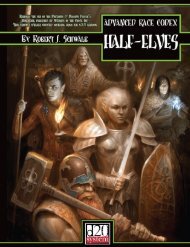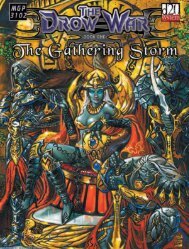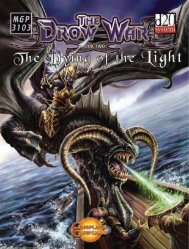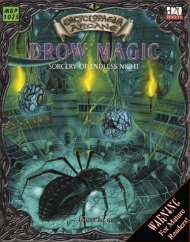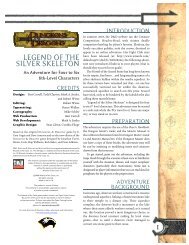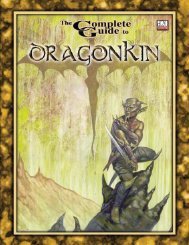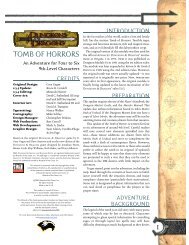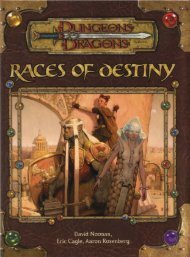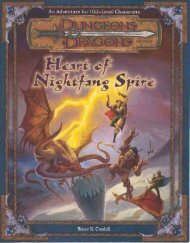Create successful ePaper yourself
Turn your PDF publications into a flip-book with our unique Google optimized e-Paper software.
In an environment like this, mercy and pity are weaknesses<br />
too easily exploited by potential enemies, weaknesses that<br />
can compromise the strength of the drow. This viewpoint<br />
extends even to the care of children.<br />
<strong>The</strong> drow notions of parenting walk a fine line. On the one<br />
hand, children are regarded as the greatest resource of the<br />
drow, the only means the race can be expected to thrive and<br />
continue, a viewpoint that dovetails easily with the natural<br />
instinct of any parent to protect his or her children. On<br />
the other hand, a coddled child cannot be coddled forever<br />
and such treatment will only leave the child unprepared to<br />
survive the rigours of life in the Underdeep, or even among<br />
his fellow drow.<br />
<strong>The</strong> most common compromise amongst the drow is as<br />
follows: a child is protected by both parents and society<br />
until such time as he can be expected to fend for himself.<br />
At that time, he will remain part of the family, obviously,<br />
but cannot expect help from anyone but himself.<br />
This is difficult for parent and child both. <strong>The</strong> parental<br />
instinct is as strong in the drow as it is in other sentient<br />
races and effectively abandoning a child to the dangers of<br />
life at such an early age is a painful experience for many<br />
parents. For this reason, many parents have little to do with<br />
the child as he or she is being raised, trusting that task to<br />
the child’s siblings, as well as any tutors or mentors the<br />
parents might be able to provide for their offspring. This<br />
separation effectively prevents the parents and child from<br />
forming overly-strong attachments toward one another.<br />
However, the multiple means of procreation in drow society<br />
(prostitution, sexual rites and so forth) often provide a<br />
certain degree of ambiguity to a child’s parentage, divorcing<br />
the child from the kind of bond a pair of mated drow might<br />
feel for him. For a child of the drow, the sudden and (at the<br />
time) inexplicable abandonment by his caretakers is often<br />
seen as a betrayal, hardening the child’s heart at an early<br />
age. Society itself benefits from this however, as the child,<br />
upon reaching adulthood, will find it easier to let his own<br />
children fend for themselves.<br />
Children are usually turned loose by their parents to learn<br />
to fend for themselves by the age or eight or nine, and<br />
certainly before the onset of puberty. By the time a drow<br />
child does reach puberty, he almost certainly will have<br />
acquired some familiarity with weapons and will likely<br />
have gained at least two levels in a character class.<br />
Orphans and children who are abandoned at birth, an<br />
uncommon but hardly unknown occurrence, face a life<br />
even more difficult than that of children born to a drow<br />
family or even within a brothel. Unless the child has the<br />
dubious fortune to be taken as a slave by a temple, guild<br />
or wealthy family, he will almost certainly not survive, as<br />
there are no orphanages or charitable institutions among<br />
the drow. Those few who do survive certainly turn out to<br />
be amongst the strongest, smartest and most determined of<br />
their kind.<br />
Cruel though it may seem to outsiders, the drow consider<br />
their child-rearing practices an absolute necessity. Forcing<br />
a child to learn to fend for himself teaches strength and selfreliance<br />
from an early age. Those who do not survive the<br />
rigours of life outside the protective arms of their parents<br />
are not mourned (except perhaps by the parents themselves)<br />
as their failure proved them to be too weak to survive alone.<br />
If the child had been protected and coddled until reaching<br />
adulthood, as is common in surface races, the child would<br />
still have been weak and that weakness in an adult would<br />
have made the drow society as a whole weaker.<br />
For many children, this ‘survival of the fittest’ approach<br />
ends with death or maiming, particularly those cultures<br />
who send youths out of the city on a hunt or expedition<br />
into the Underdeep to prove themselves. However, the<br />
vast majority survive and are made harder and stronger by<br />
the experience, sloughing off the innocence of childhood.<br />
Because of the trials all drow children endure, it is very rare<br />
to find a drow who does not have at least several levels in<br />
some character class.<br />
<strong>Drow</strong> Society<br />
Art<br />
Art is an extremely important element of drow culture.<br />
<strong>The</strong>y are fond of beauty, even though their definition of<br />
it may differ from that held by surface cultures. Still, the<br />
elegance of their works is undeniable.<br />
<strong>Drow</strong> prefer three-dimensional art such as sculpture,<br />
architecture or even pottery to two-dimensional forms such<br />
as painting or mosaics. Whether the item in question is a<br />
simple vase or a mighty sculpture running up the side of a<br />
temple, there are common themes which predominate most<br />
drow cultures. <strong>The</strong> figure or item is likely to be simple and<br />
elongated, evoking a feeling of lightness and grace.<br />
Excessive ornamentation is uncommon in most drow<br />
cultures, with a few exceptions. Rather than burden their<br />
art with the weight of incredible detail, drow artisans are<br />
adept at creating the effect of detail with just a few small<br />
strokes. A few simple cuts and chisellings, keeping in mind<br />
the play of light and shadow, can create a face on a sculpture<br />
which seems at first glance to be completely lifelike.<br />
17




